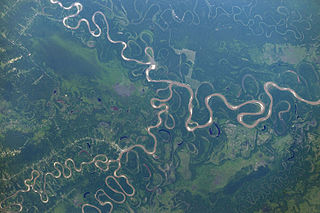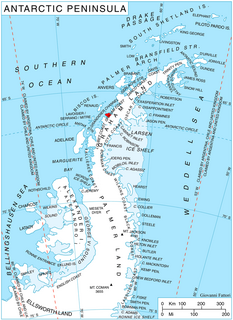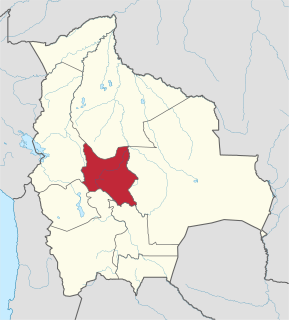
The Arctic Archipelago, also known as the Canadian Arctic Archipelago, is a group of islands north of the Canadian mainland.

The Mamoré is a large river in Bolivia and Brazil which unites with the Beni to form the Madeira, one of the largest tributaries of the Amazon. It rises on the northern slope of the Sierra de Cochabamba, east of the city of Cochabamba, and is known as the Chimoré down to its junction with the Chapare. Its larger tributaries are the Chapare, Secure, Apere, and Yacuma from the west, and the Ichilo, Guapay, Ivari, Manique and Guapore from the east. Taking into account its length only, the Guapay should be considered the upper part of the Mamore; but it is shallow and obstructed, and carries a much smaller volume of water. The Guapore also rivals the Mamore in length and volume, having its source in the Parecis plateau, Mato Grosso, Brazil, a few miles from streams flowing north-ward to the Tapajos and Amazon, and southward to the Paraguay and Paraná rivers. The Mamore is interrupted by rapids a few miles above its junction with the Beni, but a railway 300 km long has been undertaken from below the rapids of the Madeira. Above the rapids the river is navigable to Chimore, at the foot of the sierra, and most of its tributaries are navigable for long distances. In 1874, Franz Keller gave the outflow of the Mamoré at mean water level, and not including the Guapore, as 41,459 cm3/sec, and the area of its drainage basin, also not including the Guapore, as 24,299 km2.

Le Goulet is a Canadian village in Gloucester County, New Brunswick.
The Mocoretá River is a river in the Mesopotamic northeastern region of Argentina. It is born in the southeast of the province of Corrientes, south of Curuzú Cuatiá. It flows south, first turning east and then west until reaching the interprovincial border with Entre Ríos, where it receives the Las Tunas Stream. It turns southeast again along the border, passes by the town of Mocoretá, and empties into the Uruguay River, into the southern part of the Salto Grande reservoir.

Ichilo River is a Bolivian river at the foot of the Eastern Andes-Cordillera in South America. It lends its name to the Ichilo Province, one of the 15 provinces of the Santa Cruz Department of Bolivia.
Santa María de Ordás is a municipality located in the province of León, Castile and León, Spain. According to the 2004 census (INE), the municipality has a population of 372 inhabitants.
Santibáñez de la Peña is a municipality located in the province of Palencia, Castile and León, Spain. According to the 2004 census (INE), the municipality has a population of 1,392 inhabitants.
Villalba de Guardo is a municipality located in the province of Palencia, Castile and León, Spain. According to the 2004 census (INE), the municipality has a population of 228 inhabitants.

Beratón is a municipality located in the province of Soria, Castile and León, Spain. According to the 2004 census (INE), the municipality has a population of 40 inhabitants.

Drygalski Glacier is a broad glacier, 18 nautical miles long and 15 miles (24 km) wide at its head, which flows from Herbert Plateau southeast between Ruth Ridge and Kyustendil Ridge, and enters Solari Bay immediately north of Sentinel Nunatak on Nordenskjöld Coast, the east coast of Graham Land, Antarctica. It was discovered in 1902 by the Swedish Antarctic Expedition, under Otto Nordenskiöld, and named "Drygalski Bay" after Professor Erich von Drygalski. The feature was determined to be a glacier by the Falkland Islands Dependencies Survey in 1947.

Cửa Lò is a town district of Nghệ An Province, in the North Central Coast region of Vietnam. As of 2003 the district had a population of 46,185. The district covers an area of 28 km² and it is located 290 km south of Hanoi, 1400 km north of Ho Chi Minh City and 16 km northeast of Vinh City. Cửa Lò has one of the most beautiful beaches in Vietnam, and, due to its scenery, fine white sand, slopes and moderate salinity, it attracts both domestic and foreign tourists.

Chimoré is a location in the Carrasco Province, Cochabamba Department, Bolivia. It is the seat of the Chimoré Municipality.
Santiago Apóstol is a town and municipality in Oaxaca in south-western Mexico. The municipality covers an area of km². It is part of the Ocotlán District in the south of the Valles Centrales Region

Chimoré Municipality is the fourth municipal section of the Carrasco Province in the Cochabamba Department, Bolivia. Its seat is Chimoré.
Cedral, San Luis Potosí is a town and municipality in San Luis Potosí in central Mexico.

Bulkington Pass is a pass on the south side of Flask Glacier and west of Bildad Peak in Voden Heights on the east side of Graham Land. The pass trends northeast–southwest for 4 nautical miles (7 km) and provides a route from the ice piedmont north of Adit Nunatak to Flask Glacier. The toponym is one in a group applied by the UK Antarctic Place-Names Committee that reflects a whaling theme, Bulkington being a crewman on the vessel Pequod in Herman Melville's Moby Dick.
Kooyman Peak is a peak rising to 1,630 metres (5,350 ft), on the ridge just south of Dorrer Glacier in the Queen Elizabeth Range, Antarctica. It was mapped by the United States Geological Survey from tellurometer surveys and Navy air photos, 1960–62, and was named by the Advisory Committee on Antarctic Names for Gerald L. Kooyman, a United States Antarctic Research Program biologist at McMurdo Station in the 1961–62, 1963–64 and 1964–65 seasons.

Sohm Glacier is a glacier flowing into Bilgeri Glacier on Velingrad Peninsula, the west coast of Graham Land. Charted by the British Graham Land Expedition (BGLE) under Rymill, 1934-37. Named by the United Kingdom Antarctic Place-Names Committee (UK-APC) in 1959 for Victor Sohm, Austrian skiing exponent who invented a special type of ski skins and ski wax.
German submarine U-717 was a Type VIIC U-boat of Nazi Germany's Kriegsmarine during World War II. The submarine was laid down on 24 April 1942 at the H. C. Stülcken Sohn yard at Hamburg, launched on 20 February 1943, and commissioned on 19 May 1943 under the command of Oberleutnant zur See Siegfried von Rothkirch und Panthen. Attached to 5th U-boat Flotilla based at Kiel, U-717 completed her training period on 31 July 1944 and was assigned to front-line service.












